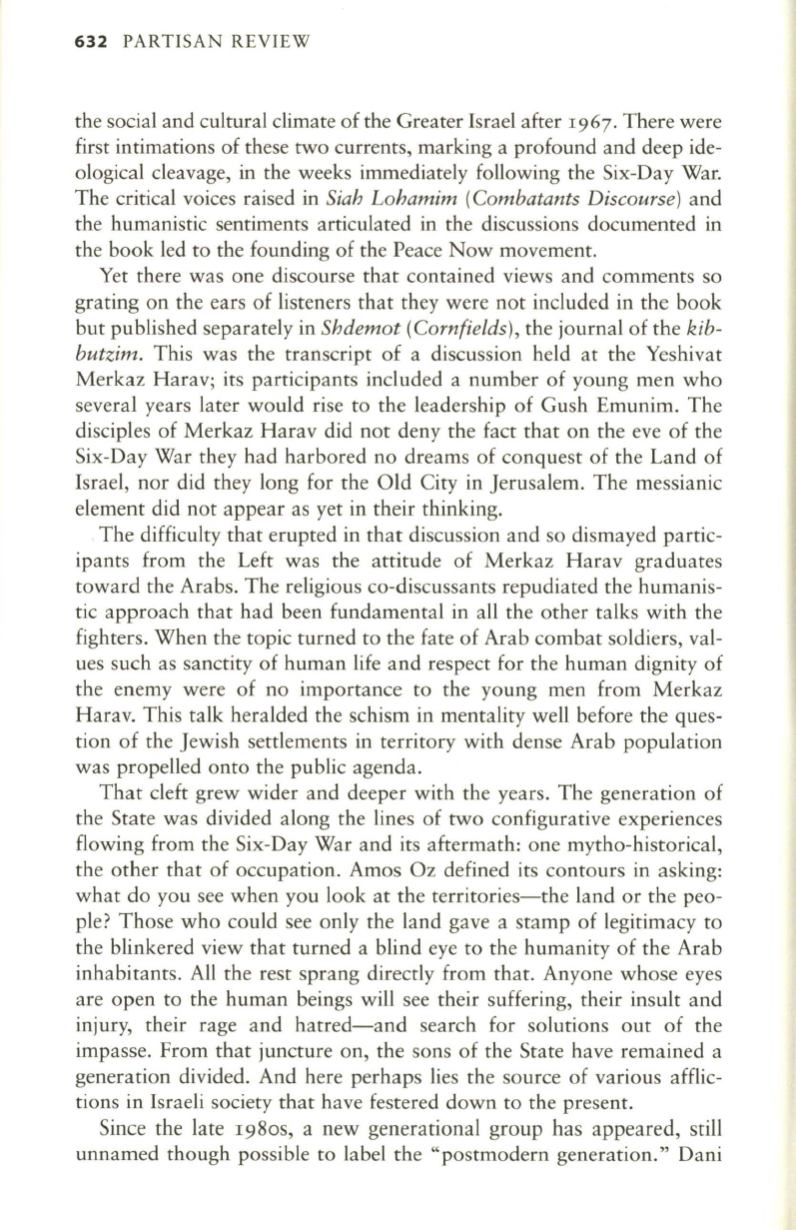
632
PARTISAN REVIEW
the social and cultural climate of the Greater Israel after I967. There were
first intimations of these two currents, marking a profound and deep ide–
ological cleavage, in the weeks immediately following the Six-Day War.
The critical voices raised in
Siah Lohamim (Combatants Discourse)
and
the humanistic sentiments articulated in the discussions documented in
the book led to the founding of the Peace Now movement.
Yet there was one discourse that contained views and comments so
grating on the ears of listeners that they were not included in the book
but published separately in
Shdemot (Cornfields),
the journal of the
kib–
butzim.
This was the transcript of a discussion held at the Yeshivat
Merkaz Harav; its participants included a number of young men who
several years later would rise to the leadership of Gush Emunim. The
disciples of Merkaz Harav did not deny the fact that on the eve of the
Six-Day War they had harbored no dreams of conquest of the Land of
Israel, nor did they long for the
Old
City in Jerusalem. The messianic
element did not appear as yet in their thinking.
The difficulty that erupted in that discussion and so dismayed partic–
ipants from the Left was the attitude of Merkaz Harav graduates
toward the Arabs. The religious co-discussants repudiated the humanis–
tic approach that had been fundamental in all the other talks with the
fighters. When the topic turned to the fate of Arab combat soldiers, val–
ues such as sanctity of human life and respect for the human dignity of
the enemy were of no importance to the young men from Merkaz
Harav. This talk heralded the schism in mentality well before the ques–
tion of the Jewish settlements in territory with dense Arab population
was propelled onto the public agenda.
That cleft grew wider and deeper with the years. The generation of
the State was divided along the lines of two configurative experiences
flowing from the Six-Day War and its aftermath: one mytho-historical,
the other that of occupation. Amos Oz defined its contours in asking:
what do you see when you look at the territories-the land or the peo–
ple? Those who could see only the land gave a stamp of legitimacy to
the blinkered view that turned a blind eye to the humanity of the Arab
inhabitants. All the rest sprang directly from that. Anyone whose eyes
are open to the human beings will see their suffering, their insult and
injury, their rage and hatred-and search for solutions out of the
impasse. From that juncture on, the sons of the State have remained a
generation divided. And here perhaps lies the source of various afflic–
tions in Israeli society that have festered down to the present.
Since the late I980s, a new generational group has appeared, still
unnamed though possible to label the "postmodern generation." Dani


